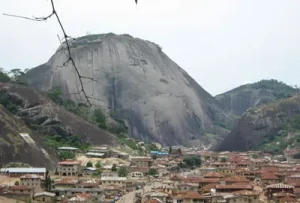How Nigerian South West Governor and Wife Undermined Tourism
OpenLife Nigeria, in its reflection on the dwarfed tourism potential across Nigeria, took a specific look at the Idanre Hills, or Oke Idanre, located in Idanre town in Ondo State of southwestern Nigeria.
The Idanre Hill, located on a Precambrian igneous batholith that is about 500 Million years old, cut by several large fracture that form deep valleys within the rocks, is well-known for its landscape.
Its wide variety on cultural sites as ‘Owa’s Palace’, shrines, The Old Court, Belfry, Agbooogun footprint, thunder water (Omi Apaara) and burial grounds have since brought the location fame.
Idanre Hill which resides 3000 ft (914.4meters) above sea level and houses a unique ecosystem upon which the cultural landscape has Integrated, was added to the UNESCO World Heritage List on October 8, 2007 in the Cultural category.
Technically, the drop in global oil prices over the past few years has exposed the vulnerabilities of Nigeria’s dependence on crude oil revenues. Although, much emphasis has been placed on agriculture being the “messianic industry”, the tourism industry, if revamped has the potential to attract substantial foreign exchange earnings. However, recent reform efforts by the government in tourism seem to reflect old thinking even in new times. Nigeria has maintained a dogmatic approach which narrowly defines tourism as arts and culture with poor emphasis on other aspects like nature and conservation. While several African countries have increased the scope of tourism to meet global benchmarks, Nigeria’s approach remains stuck in the past.
The growth of tourism in Nigeria will have a multiplier effect to equally boost the hospitality industry, aviation sector and generate more foreign exchange as a result of the sum of the natural, anthropogenic and material resources and conditions necessary for a destination attractions.

In Nigeria’s 2021 GDP, travel and tourism contributed 3.6 percent, which was equal to around 16 billion U.S. dollars.
However, in the estimation of business analysts, the development of tourism in Nigeria cannot be achieved without the collective efforts and investment commitment of a Public-Private partnership, with major efforts from local communities and state governments.
Tourist sites such as the Mambilla Plateau in Taraba, Obudu Mountain Resort in Cross Rivers, Yankari Games Reserves in Bauchi among others could be developed to world standards. The tourist market is global but states could create niches targeting tourists who have diverse and special interests.
In Ondo State specifically and a bid to make Idanre Hills more accessible to both local and foreign tourists, the governor of the State, Arakunrin Oluwarotimi Akeredolu, promised to build a cable car at the tourist center.
This promise came on February 3, 2020,
after a twitter user named ‘AkureHowFar’ suggested the idea to the governor. In its tweet, AkureHowFar captioned a picture of a cable car with :“sir, we want in Akure”
Responding to the AkureHowFar tweet, Governor Akeredolu said: “Idanre first. The views of Idanre Hills from a cable car would be quite spectacular. It is a key piece of our tourism revitalization plans.”
Governor Akeredolu’s response elicited joy in the land. There were praises and singing. Youths and other stakeholders began to prepare for what they termed Eldorado that would define the landscape with its attendant business boom and job opportunities.
But that promise never came to pass. The governor did not make any move to ensure the fulfillment of his hope raising promise.
As if the governor’s promise was a mere conjecture, hoarse and illusionary, his wife, Mrs Betty Anyanwu-Akeredolu, on a particular Sunday, posted on her Facebook page, “Forget Idanre Hills, BEMORE Summer Bootcamp is set to be the new tourist attraction in Ondo State. Believe it or Not!-Arabinrin,”
Her Facebook post was the needed statement that governor Akeredolu and his wife never meant to develop tourism in the State.
Promptly, Honourable Tajudeen Adefisoye, a member of the House of Representatives, frowned at a statement credited to the wife of the Ondo State Governor, who rated her pet project over the ancient Idanre Hills.
In a statement signed by Adefisoye, then a member of the Social Democratic Party, SDP, representing Idanre/Ifedore Constituency, and made available to newsmen by his Special Adviser on Media and Publicity, Mr Oluyemi Fasipe, on Tuesday in Akure, the Idanre-born lawmaker said that no human initiative could ever come close to the ancient Idanre Hills, which is a UNESCO-rated world heritage site and approved tourist destination for international tourists.
Beauty & Potential Of Idanre Hills, A Journalist’s Account
In the small hours of the morning, when a few cock-a-doodles announce the break of dawn and a grey blanket of mist impairs visibility, the hills give off the “Tower of Babel” effect, leading into the heavens. As the sunrise above the broad rim of hills, and the first ray of light fight its way over the horizon, the veil of mists evaporates revealing an imposing hill formation that encircles the town. I gape at the intimidating backdrop in every direction. Having arrived the town at twilight, my perception is quickly reversed in the light of the new revelations. The town is dwarfed by domineering hills against which it nestled. Neither small by population nor by settlement size, the town of Idanre stands a Lilliputian at the feet of exalted hills. Long before the Idanre Hills made the tentative list of UNESCO’s World Heritage sites in October 2007, it had attained fame and attraction as one of Nigeria’s tourist centres. The hills, 3,000 feet tall lunging after the skies, are jaw-dropping wonders.At the foot of the hills, officials of the Ondo State Tourism Board hand out N100 tickets and they provide local guides for tourists. Whether your guide is the ageing ticket officer, whose nickname is “Old Soldier” (his other alias is Eddie Murphy) or one of the litters of urchins loitering at the foot of the hills, they come well schooled in the lore and legends of the hills, as they also know the trails and the terrains. If your objective is to catch an eyeful of the ancient settlement on the hills, you are expected to part with a token. “No more than drink money,” Old Soldier emphasizes with a grin. However, to “go the whole hog” to the far-flung parts of the hills, you pay a “princely price.” Assigned to me is an 18-year-old guide. Baptist High School student, dark-skinned and gangly Dare Odere, who continually hums “Good Morning Jesus” tune is a Snoop Dog look-alike. He wastes no time before he takes charge. “If you intend to go far on the hills, it’s advisable to leave unnecessary baggage at the foot of the hills,” he tells me. “And go with plenty of water,” Old Soldier, the ticket official, cuts in.
As we proceed on our climb, my guide ruffles into the local repertoires of myths and mysteries of the hills. The history of Idanre is the stuff the romantics are made of. Once upon a time, a progeny of Oduduwa (the ancestor of the Yoruba race), who decided to leave Ile-Ife (the Yoruba’s ancestral home) with his band of followers, stole an item of inestimable value, a magic crown called “Ade Omo Oduduwa”–the crown of the Oduduwa son-for which he incurred the wrath of his kinsmen. The people of Ife pursued them deep into uncharted jungles, forcing the fleeing band to migrate farther from civilization. They kept a nomadic existence for many years until at last they came upon a range of hills, which held them in awe and bewilderment. In consternation, they exclaimed: “Idanree!” (This is wonder). The hills became their refuge, a strategic protection against their warring kinsmen and invading marauders. There they settled and lived for over 800 years until they migrated downhill in the year 1923.
There are “Nine Wonders” on the hills. And it begins with “The Great Steps” (Ibi Akasu) that lead up into the hills: 660 steps with five resting points, set at least 100 metres apart. A climb on the hills requires a regimen against fatigue and vertigo. With a rich and robust ecosystem, the hilltop is a mid-way world between the sky and the ground, consisting of great heights and yawning gorges, frightening chasms and suicidal slopes. At the pinnacle of the hills, nature is unrestrainedly benevolent: a balmy weather, clear, sunless azure sky, and a quasi-Jurassic jungle. The hills’ flora is a matrix of tropical rainforest and savannah biomes. The vegetation, luxurious and densely variegated vegetation include tall Obeche and leafy Afara and Acacia intertwined with shrubs; contrasting morphs of cacti, cashew, and coconuts palms sprouts here and there. Bananas grow among bamboos under big baobabs. Sporadic cassava cultivation indicates an agrarian occupation. The hills have a fauna of snakes. “An elephant was killed last year,” my guide informs me. He also enumerates other species of the ‘animal kingdom’ on the hill which including antelopes, apes and birds of prey. The hills also yield bumper harvests of giant snails, which the locals pick in the dead of night. There are series of streams, crystal-clear pools that tempt you for a swim. The world on the hills, in brief, is a slice of Garden of Eden.

Great stories match the great sights of the hills. The legend of the Idanre Hills is a mosaic of myths and magic, woven around Agboogun, a great hunter with supernatural ability. A popular account asserts that the great hunter asked three of his sidekicks to accompany him on a journey. On their way, he paused to inscribe hieroglyphically on a hillside, and the cryptic inscription became known as the “Unreadable Signs.” A little further, he etched on another hill, this time, broad crisscrossed strokes. This is dubbed the “Wonderful Mat.” Then he climbed the steep Aghagha Hill. At the foot of the hill, Agboogun struck his foot on the rock, leaving an imprint on its surface. The foot shaped-depression is now known as “Ese Agboogun” (Agboogun’s Footprint). He left an instruction: “Any person(s) accused of witchcraft should be made to try it for a size; it fits any foot size except those of the malevolent.”
There is also the legend of “Omi Aopara” (Thunder Water). According to local explanation, in the days of yore, it was prerequisite for warriors to gather for a drink at the stream before embarking on any war campaign. At whoever’s turn the thunder rumbled, such individuals was doomed to die at the war front, and were consequently left out of the campaign.
The ancient settlement on the hills where they lived until 1932 holds the relics of their past. There is a complete set of antique homes and huts and the remains of the Igbo Ore Primary School on the hills. The Ancient Palace, a low-roofed mud building, with an inner square supported by carved pillars, harbours a number of artifacts such as an assortment of animal skulls. Odere offers a clarification: “Every December, when Kabiyesi, Owa of Idanre, wears the ‘Ade Omo Oduduwa’ crown he ascends the hill with a cow for sacrifice. The skulls, (collected in a corner of the palace) are symbolic of the total number of years a king has spent on the throne.” Thirty-three skulls, translates to 33 years – the number of years the reigning monarch, Arubiefin IV, has sit on the throne. Every turn on the trail on the hill brings you to another breathtaking sight. A giant boulder per already spent of the throne. Spectacular but spooky is the defining aura around the historic royal abodes precariously on a hill above a hut. The Wonderful Rock is what the natives called it.
Then the mystical: A dilapidated building, a blackened slate with written words that reads in part: Off your shirt before you enter this house. “Don’t step on that!” my guide warns. It belongs to Chief Lorin (pronounced law.rin), one of the chieftains who could well be described as the de facto kingmaker. “Though a chieftain, he doesn’t wear any clothes save for a barest essential one-piece fabric,” he adds in a grave voice. Behind this abominable abode is a low-walled house with a mesh and roof. It served as prison for felons in those forgotten era. A little distance away is the court, a mud house recently renovated. Behind the court, is a clearing where the king wears the crown every year. That spot has a yarn attached too: Ile-Ife, still hell-bent on regaining its magic crown, sent a fearless hunter who succeeded in stealing the crown. Agboogun, hot on the bandit’s heels, struck the ground with a magic wand and the hunter became transfixed. When he caught up with him, he beheaded him, and retrieved the crown. On that very spot, where his was blood spilled, there, Idanre kings wear the magic crown every year. And after that annual celebration, the king must not catch a glimpse of that place through that year again; perhaps, because the mausoleum, (the final resting place for every Idanre king and “fetish chief”) is in broad view.
One particular sight that is difficult to overlook is a smoking hill in the far distance: The Orosun Hill, covered in smoky haze, from morning till night. According to a myth, Orosun was a woman warrior, a sort of fertility deity, who protected the Idanre people. She was said to have simply walked into the wild and disappeared at the foot of the hills, where her shrine is now located. From under the Orosun Hill flows Arun River, reputed to have healing power. The Orosun festival is the most celebrated fiesta of Idanre.
Idanre is a town of classic festivals. The New Yam festival (Odun Ijesu) is another great festive occasion. But none of the fiestas compares to the epic Ogun festival, celebrated annually in honour of the Yoruba god of Iron. Wole Soyinka’s 1967 poem, Idanre, brings to mind his depiction of Ogun as a cantankerous god who wrought destruction on his own people in a moment of drunkenness.
Soyinka did visit Idanre in 1962. Is there a connection between Ogun and Idanre? Yes. In Idanre town, “Lord of all witches, divine hunter” Ogun is a revered deity. Whether a reigning king of the town is a Christian or not, Ogun must have his way. There are as many as 201 daily sacrifices to be performed by the king from January 1 to December 31. Ogun is celebrated with pomp in October. During the carnival, all the high chiefs dance with their troupes, leaving the king at the end of the procession to take the last dance on the way to the hill. Like Ogun, its patron deity, the fiesta is faintly macabre, as the festive dance could become a ‘ dance of death’ for any of the chiefs overtaken by the king. Such unfortunate chieftain is condemned to a woeful year and eventual death.
From the summit of the hills, you are privy to an eagle-eyed view of the town and its surrounding: beautiful scenery contrasts sharply with the awesome perspectives. In sum, up or down the hills, Idanre offers a panoply of picturesque panorama-red, rusty rooftops; mixed architecture, angular viewpoints-all make the sprawling settlement looks like a primitive Legoland.
It is a location that can tick the boxes on the National Geographic Channel. It can compete as location for surrealistic movies. Some Yoruba filmmakers have exploited it as choice location in the past. The movie Opa Agemo was shot in Idanre.
Though not a day to catch a glimpse of white visitors, tourists come in droves, especially students and pupils on excursion. Two busloads of a Red Cross detachment from the University of Ibadan arrive just as another squad of youths is descending the hill. Ukasoanya Uche, a 500-level Agric/Environmental Engineering student who had visited the hills before, says: “People come from far places, but lack of proper logistics and adequate boarding facilities force them to leave the same day.” That is an obvious drawback.
While the town may well lack the DNA of a great city, but the Idanre Hills’ Wow Factor has tourists coming back to the modest town every year.
“Are you coming back?” Thrice I was asked.
If only to see that part of the hills the locals called ‘The Ark of Noah, “Yes, I will be back,” I acknowledge.








